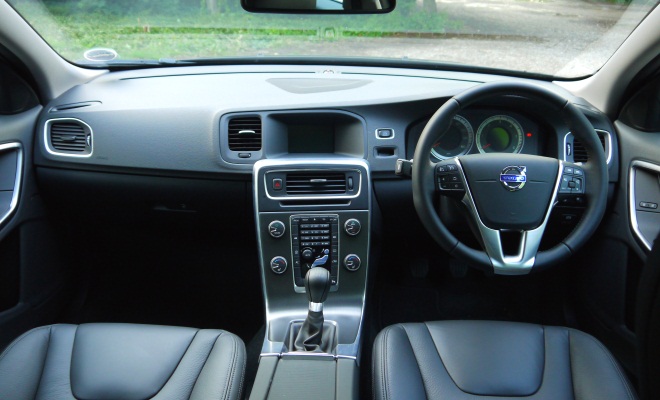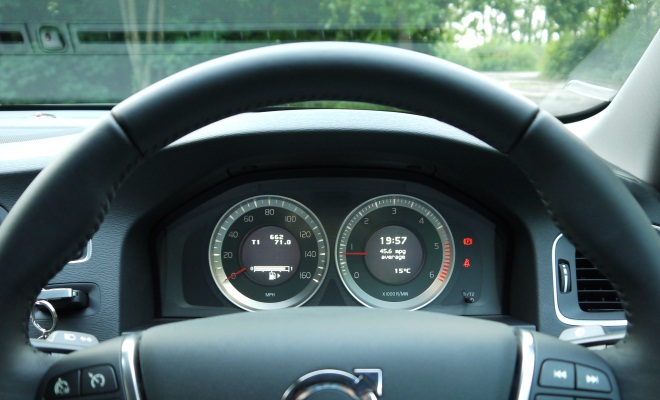
There’s a hefty, paperback-sized slab of black plastic lurking behind the rear-view mirror, as viewed from the driver’s seat of this Volvo S60. Climb out and peer back in at the crest of the windscreen and you can see the slab holds an impressive array of complicated-looking sensors. Some are part of Volvo’s innovative City Safety system, scanning the road ahead for obstructions and capable of sending urgent messages to the brakes. Apparently, if I were to ignore an impending impact, the system would step in and take over, braking very hard, at the last safe moment, to prevent the collision.
I’m not at all tempted to drive at something solid to see what happens, because one of the other sensors up there controls the rain-sensing wipers. Which are not the most attentive automatic wipers I’ve ever used. In fact they appear content to sit tight until the screen is awash with wet stuff, but once finally stirred into action keep vigorously flapping away for minutes after the shower has passed. I can just see the City Safety system following suit, and dutifully applying a fierce jolt of brakes a few moments after I’ve woken up among the settling dust with a faceful of airbag.
So we'll just have to take City Safety on trust. Fortunately it comes as standard across the S60 range, so there's no need to ponder whether it feels like money well spent.

My test vehicle is an S60 DRIVe (pronounced “drive-ee”) – the eco-label version – trimmed to SE level. That’s one rung above the base model ES, which starts from £23,495 on the road. For the SE’s extra £2,100 you get those hydrophobic wipers, rear parking sensors, power folding mirrors with puddle lamps, better audio, Bluetooth, and 17-inch alloys in place of 16s. My car also had metallic paint (£640), leather seats (£1,280), and a winter pack of seat warmers and headlamp washers (£385). Clever safety systems like blind-spot or lane departure warnings can be specified but weren’t fitted to my S60.
If you want the DRIVe spec you don’t get to choose your engine – it’s a four-pot 1.6-litre turbodiesel boasting a meagre 115bhp.
Now I’m no fan of the aggressive, overpowered, over-tyred executive saloons that can be found bothering bootlids on any given British motorway, but even I paused to wonder if 115bhp was enough. Would it have the lungs to lug around a full-sized Volvo weighing 1,500kg?
I shouldn’t have worried. While power really matters when it comes to sustained high speed, it’s torque that gives a car its get up and go. And here Volvo’s modest oilburner finds its feet, mustering up 270Nm from way down at 1,750rpm. Enough to drag this green-label saloon around with ease, even sprinting from rest to 62mph in a fairly fleet 10.4 seconds.

Vibration, rattles and the labouring noises of an engine in distress are there if you go looking for them, but if you stir the gearstick as instructed by the dashboard shift indicator, the engine remains a willing and refined companion. The leather-topped lever is nicely precise too, even if it does make you feel somewhat like you’re lining up to pot a red with every shift. The stubby lever falls easily to hand, but the chunky, immovable centre armrest forces your elbow into the air in pool-hall fashion as you work up and down the six forward speeds. Sadly there’s no relaxing auto option if you want the DRIVe-spec with its tax-busting 114 g/km CO2 score.
That downsized motor is the only real clue to the tricks Volvo has played to get such a big, spacious car under 120 grams. If you squat down at the front, you might notice that much of the grille has been blanked off to reduce drag. But there are no other signs beyond the badge on the rump. The wheels are fashionable 17-inch spoked alloys, shod with 50-profile ContiSport Contact3 tyres rather than low-resistance eco slippers. The suspension is not uncomfortably hunkered down, and the gearing feels naturally spaced.

There’s stop-start of course, which functions with faultless precision. The engine halts when the car is stationary in neutral, and restarts as you depress the clutch to engage first gear before moving off. Dipping the clutch will reanimate a stalled engine, and changing your mind just at the moment the engine switches off fails to outfox the system. The engine is always there thrumming away when it’s needed, but sits silent and still when it isn’t.
If you don’t want the engine to cut out, you can keep it running by hitting a small button ahead of the gearlever that carries the DRIVe logo. One touch will immediately start a stopped engine and prevent it from going into hibernation again until either the button is pressed again, or the car is switched off. By default, the S60 wakes up with stop-start enabled.
In the cockpit, the ambience is suitably plush. The seats are fantastically comfortable. All the plastics look and feel top drawer, the shapes are restrained and buttons all sited logically. The wheel-mounted cruise control buttons couldn’t be simpler or more instantly intuitive, and I liked and used the facility to set a limit on speed, beyond which further throttle inputs are simply ignored. It’s a great feature for motorway cruising, particularly if your licence isn’t pristine. The S60 would be a great motorway mile muncher, if only there was somewhere to rest your left shoe. No doubt the home-market left-hooker has a footrest.
At least it’s quiet, and capable of climbing motorway inclines in sixth, so once you’ve wedged your foot under the clutch you don’t have to worry about extricating it. At 70mph in top the engine spins at just 2100rpm, good for a steady 55mpg and yet also capable of quickly summoning enough torque for relaxed overtaking. The official combined cycle result is an optimistic 65.7mpg. I managed 47.3mpg, according to the car itself, although about a quarter of my test miles were done in heavy traffic.

Major drawbacks? I’m not sure I could live with the S60’s electronic handbrake. It’s activated by a little flap hiding down to the right of the steering wheel. You pull the lever to release, and push it to engage. In other words, it requires an upside-down action performed with the wrong hand. And there was no hill-hold to stop my test car rolling back, so I had to release (by which I mean pull) the lever at the right time with the wrong hand to perform a safe hill start. It quite reminded me of learning to drive, which is one memory lane I didn’t particularly want to roll down backwards.
All in all, the S60 DRIVe’s faults are mostly niggles, but it’s a shame that they are there at all. This is a good car with a few too many ragged edges.
I wanted to like the S60, but it left me unconvinced. It turns out 115bhp is quite enough to move the car, but the car itself didn’t manage to move me.

Volvo S60 DRIVe - review
28 June 2011
Read more about: fuel economy test drives Volvo



